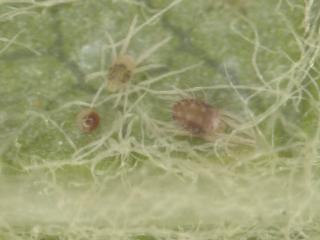European red mite
European red mite (Panonychus ulmi) was first detected in Western Australian orchards during the 2004/05 season in the Manjimup/Pemberton region. Since then, it has been recorded from all fruit growing regions in WA. It is mainly a pest of apples, but can also be a pest of summerfruit (stone fruit) crops, especially plums. European red mite is similar in shape to two-spotted mite, but is red and has more prominent spines on its back. Adult male mites are pale yellow and have longer legs than females. Like bryobia mite it has red eggs, but differs in that a spine protrudes from the apex of eggs.
Deciding when to treat
Overwintering European red mite eggs are susceptible to oil sprays near hatching. An appropriate time to apply a summer oil is just after full bloom to early petal fall. The decision to spray should be based on the extent of the leaf infestation near the end of the previous season, and the presence of large numbers of overwintering eggs.
To decide whether other miticides should be applied later in the season, follow the two-spotted mite recommendations including applying abamectin early and leaf monitoring.
Suggested action thresholds
Leaf scorch in pears has not been reported for European red mite. As a result, the action thresholds recommended for infestations are the same for all deciduous fruit. European red mite feeding causes mottling on the upper surface of leaves. During early infestation there are no symptoms on the lower surfaces, but with high infestations, leaf bronzing and leaf fall may occur.
For the ovicides clofentezine (for example Apollo) and hexythiazox (for example Calibre, Hexythiazox and Zilch), alone, apply at around 10% leaf infestation.
For ovicides mixed with miticides that control motile stages (mobile stages after hatching) as well as for miticide where ovicides are not included, apply at 30 to 40% leaf infestation.
Resistance management
As is the case for two-spotted mite, European red mite can develop miticide resistance. Adopt the same principles of resistance management as described for two-spotted mite.

